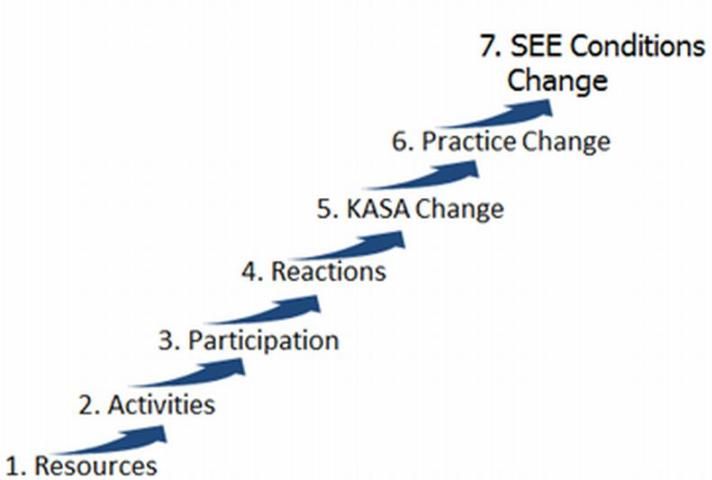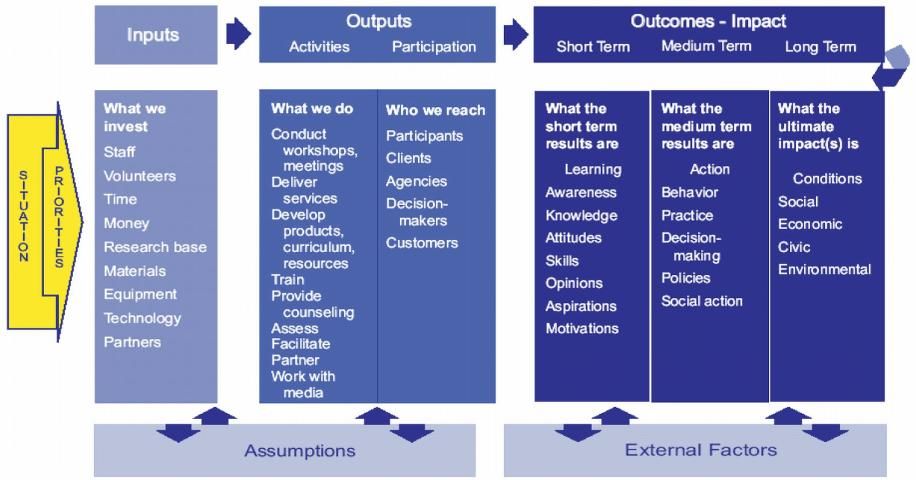Introduction
Developing an effective Cooperative Extension program is not easy. Factors that can affect the quality of a program include the needs of clientele, the content and sequence of educational activities, availability of resources, and coordination among county faculty, state specialists, and administrators. In addition, a needs assessment is the foundation of an effective program because it points to the educational needs of clients and serves as the basis for specifying a program's outcomes. This step in the planning process facilitates the development of an Extension program that can deliver the right information to the appropriate clients in a way in which they can understand and apply it.
The logic model is a useful tool for planning an effective Extension program. Logic models identify program outcomes, the learning processes in which clients are to engage, and the organization of people, partners, and resources needed to deliver educational activities (Rossi, Lipsey, & Henry, 2018). Well-conceived logic models are based on relevant disciplinary research and developed in consultation with other faculty, advisory council members, potential clients, and stakeholders.
Logic models help us to think through plans for the program (Kellogg Foundation, 2004). The process of developing a model forces us to examine and make explicit assumptions about how the program will work. Creating a logic model, for example, helps us to consider questions like, "What do clients need to learn in order to change their behavior?" and "Are clients ready to participate and motivated to learn?" A logic model also can help us communicate more clearly with our colleagues, advisory councils, and local stakeholders about the internal workings of the program.
What is a logic model?
Logic models are often presented as diagrams, charts, or tables that show the major components of a program. In the case of diagrams, arrows are used to link the components of the model and reflect the sequence of events necessary for the program to be effective. Figure 1 illustrates a reduced logic model for the community nutrition education program of the USDA’s Supplemental Nutrition Assistance Program (SNAP). The model shows a sequence of activities and outcomes. Another way to think about logic models is as a set of "if-then" relationships, which show that if implemented as intended, then desired outcomes should result (Taylor-Powell & Henert, 2008). Using this model as an example, we can apply "if-then" logic by saying, "If I conduct conduct SNAP training for parents, then the parents' knowledge will increase." and "If parents increase their knowledge of food nutrition, then they will eat healthier food."

Credit: https://www.nifa.usda.gov/sites/default/files/resource/SNAP-Ed-Through-the-LGU-for-FY2010-Report-A-Retrospective-Review.pdf
In short, logic models serve as the blueprint for building an Extension program and are a valuable tool for planning an evaluation. They can also serve as supporting materials for communicating the results of an evaluation. Stakeholders can use them to easily identify the program elements or processes that need to be changed.
In addition to a diagram, logic models can include narratives that explain the relationships between the components. Fully specified logic models also identify factors external to the program that can hinder the program staff's efforts or help them achieve the program's objectives. Logic models can also indicate factors that affect recruiting participants into the program. In addition, a fully specified model may include assumptions and a description of the situation (or need for the program). A well-reasoned logic model draws upon disciplinary knowledge bases to establish the likely outcomes of program activities.
The use of logic models in Extension has its roots in Claude Bennett's (1979) chain of events model and its progeny, the Targeting Outcomes of Programs (TOP) model (Rockwell & Bennett, 2004). The chain of events model identifies a sequence of seven categories of program elements and outcomes, with the latter including changes in knowledge, attitudes, skills, and aspirations (KASA); changes in behavior or practice; and changes in social, economic, and environmental conditions (SEE conditions) (Figure 2).

Several different types of logic models are widely used today. The most common type of logic model is a chart or table, as exemplified by the Wisconsin model (Taylor-Powell, 2002) shown in Figure 3. The USDA-NIFA (n.d.) uses a nearly identical model for many of its grant programs. Taylor-Powell's model links a sequence of short-, medium-, and long-term outcomes to program outputs and inputs. An examination of the Wisconsin model reveals many subcategories that might be relevant within the broader topics of outcomes, outputs, and inputs. In addition, a more complete specification of the Wisconsin model includes consideration of the situation (needs assessment information), assumptions, and external factors that have the potential to impact outcomes.

Credit: https://logicmodel.extension.wisc.edu/introduction-overview/section-1-what-is-a-logic-model/1-9-full-logic-model-framework/
Other types of logic models include the outcome sequence model (Hatry, 1999) or impact theory model (Rossi et al., 2018). These models focus on describing causal connections between specific outcomes and specific activities. For example, a seminar on healthy snack foods can be expected to improve knowledge about foods for a diet and health program, but the seminar would not be expected to affect knowledge about the benefits of exercise (which would require another seminar on that topic). Outcome sequence models are also often used as a basis for identifying the program's performance measures because components that are important enough to include in the model should also be the focus for performance measurement (Hatry, 1999). A second type of model, the process theory model, describes the interaction between Extension professionals (i.e., agents and specialists) and clients, as well as the internal organization of the program (Israel, 2001; Rossi et al., 2004).
Steps for Creating a Basic Logic Model
Logic models can also be developed using the traditional horizontal diagram like the one shown in Figure 3 or a vertical version (see the Appendix).
- Identify important outcomes. The first step is to identify the major components of the program's outcomes. These outcomes should emerge from a priority setting process based on a careful analysis of needs. Outcomes may be short term, intermediate, or long term. Start by identifying the long-term outcomes. Long-term outcomes include changes in social, economic, and environmental (SEE) conditions (Rockwell & Bennett, 2004). For example, one long-term social outcome for the community nutrition education program in Figure 1 is fewer health problems among children and parents who participate in the SNAP program.
Intermediate outcomes usually include adopting best management practices (BMPs), using appropriate technologies, changing individuals' behavior, or, at the group level, developing new relationships (such as forming a farmers' cooperative or community organization). The most important intermediate outcomes include changes in behavior and adoption of practices. Changes can be made to either a single behavior or to a combination or set of practices and technologies. For example, the community nutrition education program shown in Figure 1 might focus on necessary nutrition changes of healthier cooking, incorporating more fruits and vegetables in meal planning, and using new shopping strategies. The needs of the audience would determine whether or not a single behavior change is needed, or that a combination of changes in a particular order is needed.
Finally, short-term outcomes are changes in knowledge, attitudes, skills, and aspirations (KASA). Did the audience gain knowledge? Did they learn a new skill (such as plant identification)? Do they have a more positive attitude toward a specific behavior change? Do they aspire to do something as a result of the program? These outcomes should be specific and are the easiest to measure. Because participation in Extension programs is voluntary, the number of participants, the intensity of participation, and the satisfaction with the program are considered by some experts to be aspects of short-term outcomes (Hatry, 1999).
For many programs, some audience segments or groups may have outcomes that are different from those of other groups. This is because needs vary—one group of clients might need information on one topic, while a second group might need information on a related topic, and a third group might need information on an array of topics. In this situation, developing a logic model for each group can help focus the program to deliver the needed information to the appropriate group.
2. Create a logical sequence of events. The second step in creating a logic model is to organize the outcomes in a sequence or chain of events and identify external factors that can hinder or facilitate the program. When planning a program, start with the end. That is, start with a focus on the outcomes that clients need to achieve. Then work back to identify the steps necessary to achieve these outcomes. Doing so better ensures that the outcomes will occur. Using the "work backward" planning perspective for the community nutrition education program in Figure 1, ask "What needs to be done to reduce health problems or food insecurity?" Given that research shows smart food shopping techniques and using more fresh fruits and vegetables can reduce food insecurity and health problems, the next question is, "What specific food-handling BMPs need to be adopted?" This process of working backward is continued until a complete logic model is identified. Fundamentally, the sequence of outcomes is based on expectations about cause and effect relationships between program activities and resources and short-term outcomes, short-term and intermediate outcomes, and intermediate and long-term outcomes (Rossi et al., 2004).
3. Obtain comments from others. The third step is the review and consultation process. Though the initial development of logic models can be completed quickly by a small group, much can be gained by involving the full membership of programmatic teams, county and state faculty, interested administrators, external peers, and stakeholders.
Broad-based involvement helps to ensure that the model is correctly specified and based on relevant research. When gaps in the model are identified, it can be corrected before scarce resources are wasted on ineffective activities. More importantly, those who participate in the model's development will be more likely to share a commitment to the program's objectives and activities, even if these may lie outside his or her expertise.
Concluding Comments
For logic models to serve a useful planning function, it is important to begin by specifying the program's desired outcomes and then working backward. Starting with the program's current activities can lead to maintaining the status quo instead of engaging in a careful, research-based discussion of the rationale for the program (Hatry, 1999). Creating a logic model helps faculty focus educational programs on generating outcomes for clients and including the necessary components for attaining those outcomes. The completion of a detailed logic model enables Extension faculty to be confident that their efforts will be effective and their resources well spent. The time spent developing a logic model should be viewed as an investment rather than an expense. Given the public's expectations for performance, faculty can ill afford not to use logic models as a tool for program planning.
References
Bennett, C. (1979). Analyzing impacts of Extension programs (ESC-575). Washington, DC: USDA Science and Education Administration.
Hatry, H. P. (1999.) Performance measurement: Getting results. Washington, DC: The Urban Institute Press.
Israel, G. D. (2001.) Using logic models for program development. Gainesville: University of Florida Institute of Food and Agricultural Sciences. https://edis.ifas.ufl.edu/publication/WC041
Kellogg Foundation. (2004). Logic model development guide. Retrieved from https://www.naccho.org/uploads/downloadable-resources/Programs/Public-Health-Infrastructure/KelloggLogicModelGuide_161122_162808.pdf
Rockwell, K., & Bennett, C. (2004). Targeting outcomes of programs: A hierarchy for targeting outcomes and evaluating their achievement. Retrieved from https://digitalcommons.unl.edu/cgi/viewcontent.cgi?referer=https://www.google.com/&httpsredir=1&article=1047&context=aglecfacpub
Rossi, P. H., Lipsey, M. W., & Henry, G. T. (2018). Evaluation: A systematic approach (8th ed.). Newberry Park, CA: Sage Publications.
Taylor-Powell, E., & Henert, E. (2008). Developing a logic model: Teaching and training guide. https://fyi.extension.wisc.edu/programdevelopment/files/2016/03/lmguidecomplete.pdf
U.S. Department of Agriculture, National Institute of Food and Agriculture (USDA-NIFA). (n.d.). Generic logic model for NIFA reporting. https://nifa.usda.gov/sites/default/files/resource/Generic%20Logic%20Model%20for%20NIFA%20Reporting.pdf
